Cultivating Aesthetics in the Information Age
In todays new media culture – an individual can learn and gather the tools and information needed to perfect a skill. Speaking to the design landscape, the question emerges as to whether a good aesthetic point of view is inherent in the designer, maker or creator – or if it can be cultivated.
As aesthetics are truly a ‘point of view’ discussion, the issue is truly how an individual interprets, evaluates and responds to an environment, problem or opportunity. Focusing on branding and perception, design leans heavily on first impressions of the personality, appearance, and professionalism of a brand. Those impressions are what the mind experiences with the most impact, accompanied with residual feelings that act like faint images of those initial effects – causing either a conversion or a missed opportunity.
Design is truly a reflection of the times, landscape and culture it resides in. With regard to website design, in order to play with an aesthetic point of view catering to each brand, it’s important to adhere to a few ‘good design’ guidelines so the point of view has the opportunity to shine through.
Keeping the layout consistent cannot be emphasized enough. We are all creatures of routine and habit, which directly translates into our web usage. It has been shown that consistency draws to the visual center of the human brain, and positively adds to the user experience. Maintaining the same layout, voice, look and feel throughout your entire website and mobile design (e.g. keeping significant buttons in the same spot on the page), will greatly maximize usability and clarity allowing users to find the information they need.
Unsure how to implement that clarity? Immerse all design practices in minimalism/simplicity – keeping the environment clean. Directly from an art perspective, aesthetics takes multiple elements into consideration, such as coloring and font, ensuring consistency with any and all visitor expectations. Take full advantage of a simplistic approach, making the process of finding information smoother for the brand and for its audience to.
Utilize clear lines that display your company’s branch of philosophy dealing with the nature of art, beauty, and taste, with the creation and appreciation of beauty. Scientifically, it has been approached as the study of sensory or sensori-emotional values, defined subjectively and according to personal taste. Message in three sentences or less, with engaging graphics and confident, coordinated colors that embody your vision without needless clutter.
This simplicity is actually scientifically appealing – visual memory describes the relationship between perceptual processing and the encoding, storage and retrieval of the resulting neural representations. What does this mean? The human eye is naturally drawn to what it already knows, and finds comfort in that familiarity. Catering to those expectations should be as natural as breathing. By crafting the interface accordingly, you make the designed website or app feel like home to the intended users, allowing them access to the information they need to achieve their goal.
All of these creative opportunities have the ability to reshape the future of how we interact with all of our technology. Brands must design beyond the laptop and PC and optimize for their growing mobile audience – keep moving forward towards the optimal experience.
Since all of the senses (ideally) come into play within aestheticism, designers have learned to play with the elements of composition as they craft the perfect interface. Aiming for absolute beauty within a competitive market have honed the tools and idea generation that keep designers on their toes have produced incredible results – in an effort to surge ahead of competition, developments like responsive web design, parallax, SVGs (scalable vector graphics) have been built.
What an inspiring concept – that which makes us forge ahead and advance creates beautiful innovation.



